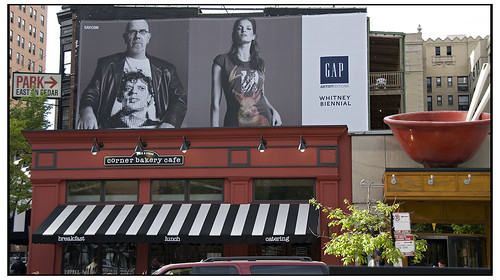
[click for a larger view]
Stick it to the man, part 848.
How a Gold Coast billboard lives on despite the City of Chicago, the Illinois Supreme Court, a federal court and 2 appeals courts
How a Gold Coast billboard lives on despite the City of Chicago, the Illinois Supreme Court, a federal court and 2 appeals courts.After Bernard Heerey bought a four-story building in Chicago's Gold Coast at the start of 1961, he rented out its bare brick wall overlooking the junction of State and Rush Streets for advertising, later expanding the size of the sign and adding a row of bright lights, all without permits.
In 1986, the city took notice and eventually ordered it down. More than two decades later, the fight goes on, and the sign remains in place, long after Heerey's death in 1999.
The epic legal battle over 1127-33 N. State St. has been waged in administrative hearings on up to the Illinois Supreme Court. It resulted in a federal trial and took two trips through the 7th Circuit Court of Appeals, where representatives of Heerey's estate endured their latest legal defeat earlier this month. They have vowed to carry on the dispute.
Meanwhile, a wall that over time has displayed ads for cigarettes and liquor, Target and The Gap, now shows a bald guy and a sultry brunette modeling "artist-edition T-shirts" as they gaze toward Gibsons Steakhouse on the street below. All along, this prominent spot in the heart of the city's swankiest neighborhood has generated a nice income—it's now leasing for $99,074 a year.
[From The sign that won't go away]
There should be a statute of limitations on these things - it isn't as if there are no other billboards in the area. Also, the bulk of Heerey's estate was donated to charity - shouldn't the City of Chicago fight other things instead?
Heerey, who gave the bulk of his substantial estate to charity when he died at age 79, left the Near North Side in much better condition than he found it, said Nathaniel Grey, his longtime lawyer. Though the State Street address was valuable all along, some of Heerey's commercial real-estate deals involved tearing down "slums" and "firetraps" to make way for the affluent neighborhood of today, Grey said.
"He helped clean out the area," he said. "He was quite a guy. He worked hard. He made money."
